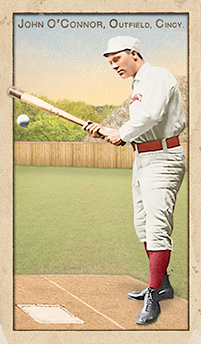
- Series: Beginnings: 1880's
- City: Cincinnati
- Team: Red Stockings (AA)
- League: American Association
John Joseph O’Connor (1866-1937) was as durable as they come. He holds the distinction, with a mere 28 others, of playing in four different decades in the majors. His durability was a product of his toughness. Despite the benign-sounding nickname of “Peach Pie,” O’Connor was known as one of the dirtiest players of his day and hard as nails. He excelled behind the plate, a position that devoured its occupants. With the Cleveland Spiders from 1892-98, O’Connor (also known as “Rowdy Jack”) hit .290+ four straight seasons. In his 21-year big league career, Jack hit a fine .263 He had started out with Cincinnati’s Red Stockings in 1887 and stayed in the Buckeye State with the Columbus Solons and Cleveland until he moved to St. Louis following the ‘98 campaign. He would move on to Pittsburgh and New York before landing back in St. Louis in 1904 where he remained through 1910.
Jack's waning days in St. Louis proved fateful for he and two of the game's all-time great hitters. Nap Lajoie and Ty Cobb were locked in a memorable duel for the batting title (and thus, the 1910 Chalmers Award) as the season wound down. O’Connor was the player/manager of the Browns when Lajoie’s Naps came to town for a season-ending double-header at Sportsman’s Park. History doesn’t record why O’Connor so strongly preferred Nap to win the title, but we might suppose Cobb wasn’t any more beloved in St. Louis than elsewhere. In any event, “Peach Pie” ordered his rookie third baseman Red Corriden to play back . . . way back, as in short left field. Lajoie proceeded to drop five bunts down the line, all for base hits. Lajoie reached base on his 6th at bat on a fielder's error, but O'Connor tried to bribe the official scorer to change the error to a hit, even offering to buy the woman a new wardrobe. The batting title and Chalmers Award went to Cobb despite the host’s accommodation. The difference in final average was minute, and the controversy inspired Chalmers to give both Lajoie and Cobb new cars. But the escapade cost O’Connor his job as league president Ban Johnson ordered him and Browns' owner Robert Hedges fired and banned. Decades later, research found Cobb had been double-credited with one day’s results. In 1981 Lajoie was declared the true winner of the batting title for 1910, by seven thousandths of a point. Rowdy Jack’s revenge….
- O'Connor's stunt got him blacklisted and unofficially banned from major league baseball for life
- At age 46, Jack returned to Cleveland’s Forest City club in 1912 for a last hurrah. No data survives for that team’s year but Baseball Reference records O’Connor managed the squad
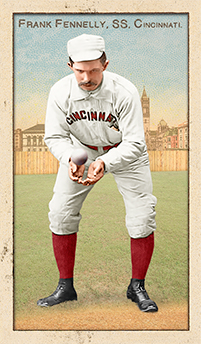
- Series: Beginnings: 1880's
- City: Cincinnati
- Team: Red Stockings (AA)
- League: American Association
Francis John Fennelly (1860-1920) came out of Fall River, MA to whack 34 career home-runs in the American Association. Not a bad sum for the era of flabby, misshapen baseballs. And, thanks to careful research, Frank’s effectiveness swinging a stout wooden implement does, indeed, exceed the prowess of his classmate and more famous hometown slugger, Lizzie Borden. Despite the scurrilous playground rhyme to the contrary, Lizzie used only about 30 blows to become the most famous self-made orphan in New England. Frank’s more prosaic career took him to Washington as a rookie with the Nationals in 1884 where he led the team in batting as their shortstop. He finished his debut year with Cincinnati where he hit .352 and earned his keep until traded to the Athletics during the ‘88 season. A brief stint with the Brooklyn Gladiators in 1890 concluded his major league experience. Overall, Fennelly’s BA was .257 with 175 stolen bases. He led the American Association in RBI (89) in 1885.
- The notorious axe murders occurred in 1892; two years after Frank returned home
- Frank was born six months before Lizzie, who outlived him by seven years
- Frank is buried in St. Patrick’s Cemetery; Lizzie is buried in Oak Grove Cemetery, next to her parents
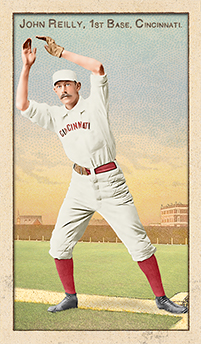
- Series: Beginnings: 1880's
- City: Cincinnati
- Team: Red Stockings (AA)
- League: American Association
John Good Reilly (1858-1937) was a one-man Big Red Machine long before the days of Bench, Morgan and Rose. When he was replaced at first base by Charles Comiskey in 1892, Long John held the Cincinnati Reds franchise records for singles, doubles, triples, home runs, runs scored, RBI, and games played. His decade with the Reds had seen Reilly consistently rank in the league's top ten in most offensive categories. In addition, his lean 6’3” frame made him a welcome first base target for his teammates. To this day, after more than a century of powerhouses in the Queen City, Reilly remains one of only four in team history to twice lead the league in HRs. In 2012 he was inducted into the Cincinnati Reds Hall of Fame, which according to the team’s website is the oldest continually operating team Hall of Fame.
- Reilly had been orphaned at age three when his father died in the Battle of Fort Donelson while serving as captain of a Union ironclad gunboat
- Long John grew up in Cincinnati as a professional artist until lured by his love of baseball. He was loyal to his hometown, retiring rather than moving to another club
- 69 career home runs were impressive for the era
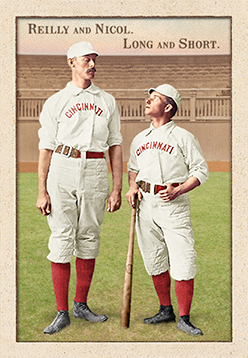
- Series: 1880s: Diamond Duos
- City: Cincinnati
- Team: Red Stockings (AA)
- League: American Association
John Reilly:
John Good Reilly (1858-1937) was a one-man Big Red Machine long before the days of Bench, Morgan and Rose. When he was replaced at first base by Charles Comiskey in 1892, Long John held the Cincinnati record in singles, doubles, triples, home runs, runs scored, RBI, and games played. His decade with the Reds had seen Reilly consistently rank in the league top ten in most offensive categories. In addition, his lean 6’3” frame made him a welcome target for his teammates. To this day, after more than a century of powerhouses in the Queen City, Reilly remains one of only four in team history to twice lead the league in HRs. In 2012 he was inducted into the Cincinnati Reds Hall of Fame, which according to the team’s website is the oldest continually operating team Hall of Fame.
- Reilly had been orphaned at age three when his father died in the Battle of Fort Donelson while serving as captain of a Union ironclad gunboat
- Long John grew up in Cincinnati as a professional artist until lured by his love of baseball. He was loyal to his hometown, retiring rather than moving to another club
- Career home runs were impressive for the era at 69
Hugh Nicol:
Hugh N. Nicol (1858-1921) was one of the great “little men” in all of baseball. This Scottish immigrant arrived in Rockford, IL in 1865 and grew up playing a mid-west style of ball that would suit him for great accomplishments in the major leagues. After only two years with his hometown White Stockings, the Chicago version called him up to Cap Anson's powerhouse in 1881. He was only a part-timer for the champion club in his first two seasons before his speed caught the attention of Chris Von der Ahe and Hugh moved to the Browns. “Little Nic” became a favorite with his outfield speed and accurate arm. Measuring speed on the bases is particularly challenging in evaluating 19th century players as “stolen bases” didn't factor into record-keeping for a long time and rules changed into the '90s. Nevertheless, Nicol's 138 steals credited in 1887 surely rank him among the greats. SABR's Charles Faber notes that this accomplishment came at age 29, leaving it to the imagination how many this speedster swiped in his early years. Hugh set this all-time record for his new club, the Reds, after being part of MLB's first trade. Von der Ahe sent Nicol to Cincinnati for Jack Doyle and $400 after the '86 campaign. His fame preceded Hugh to the Queen City, as reported by The Sporting News: “Hugh Nicol's addition to the Cincinnati team means chain-lightening on the bases. He is worth all the young blood in Christendom.” The diminutive (5'4” 145lbs) utility man never hit very well, although he did shine in his first season in St Louis with a .285 average. His ten-year ML tenure saw him hit .235 for three clubs before returning to the minors and a managerial career that lasted through the 1905 season with various Illinois teams.
- The light-hitting Nicol had a highlight game for the Browns in late 1883 as the club was seeking to overtake the Phils. Hugh went five-for-five with a walk and scored five times. The Browns fell one game short of Philadelphia for the pennant
Auction History
Cartophilia
Old Judge Pose: 346-7
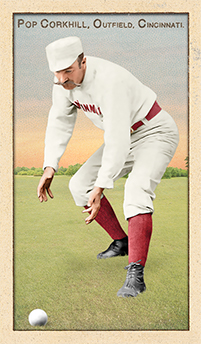
- Series: Beginnings: 1880's
- City: Cincinnati
- Team: Red Stockings (AA)
- League: American Association
John Stewart Corkhill (1858-1921) was an excellent fielder who found steady work in the outfields of the Red Stockings and Bridegrooms from 1883-90. Pop was still in demand and played out his career in Philadelphia and Pittsburgh before a beanball served up by Ed Crane prompted the veteran to hang ‘em up in 1892. Corkhill led the league in fielding several times, twice with his first club in Cincinnati and twice in Brooklyn where he played for pennant-winners in ‘89 (NL) and ‘90 (AA). A clutch hitter, Pop drove in 97/97/93 during a fine stretch from 1886-88. Proving his versatility, Corkhill made relief appearances in five seasons. He recorded two saves in an era not known for bullpen assistance.
- Corkhill was acquired by Brooklyn late in the ‘88 season along with the notoriously voluble Oyster Burns as owner Charles Byrne assembled a powerful squad
- Pop’s NY Times obituary noted that he had established a record with Cincinnati, playing three consecutive years without dropping a fly ball
- Corkhill passed away at home following surgery. It is unknown whether this was related to his career-ending injury




